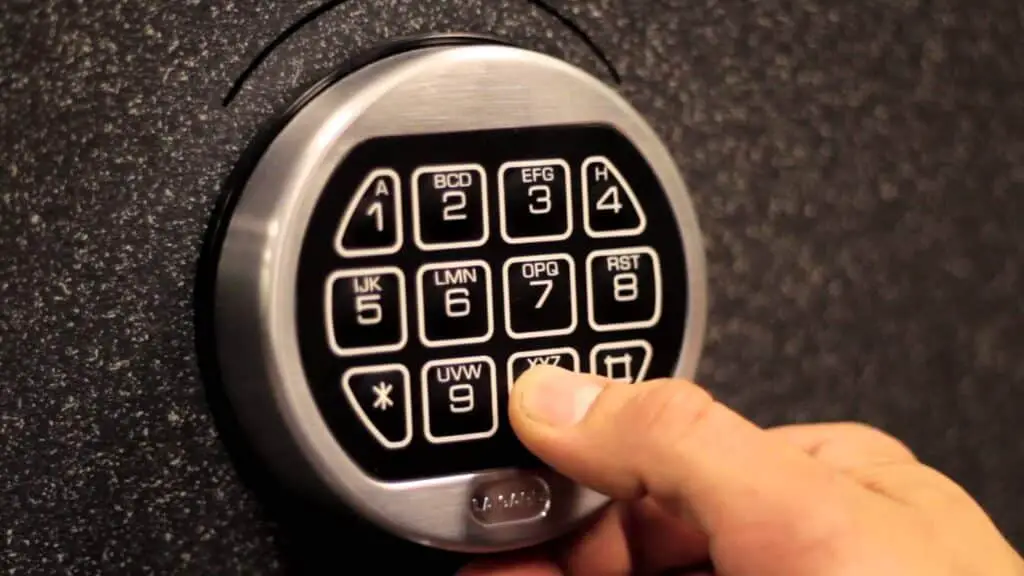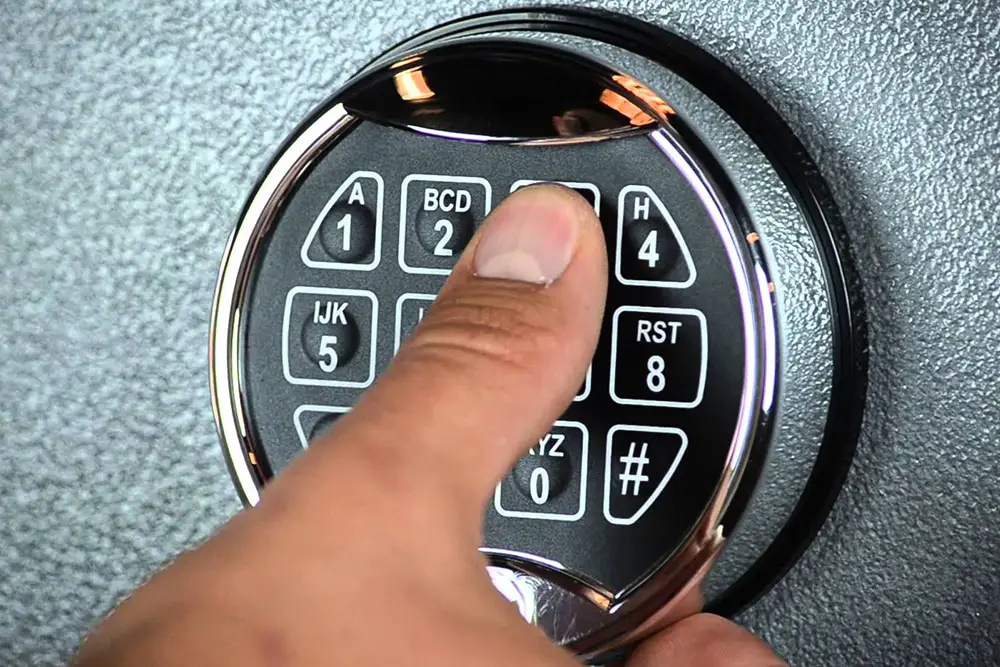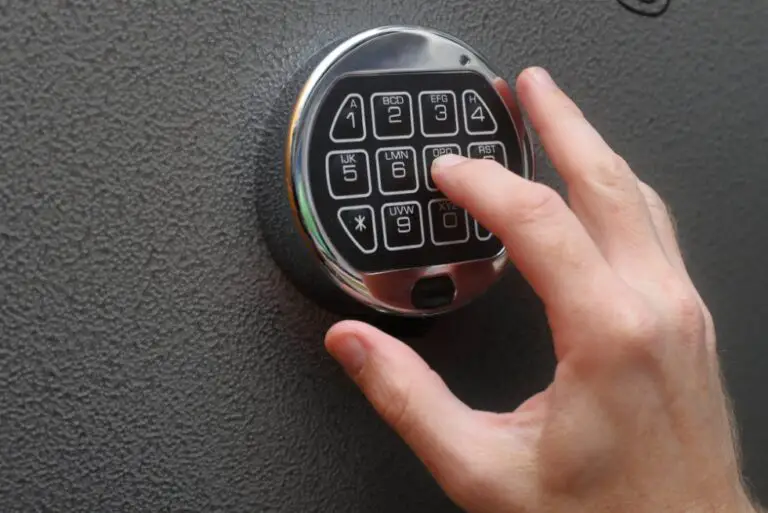Introduction
Are Keypad Locks Safe: Keypad locks, a modern alternative to traditional key-based locks, have gained prominence for their convenience and potential to enhance security. These locks rely on personal identification numbers (PINs) to grant access, eliminating the need for physical keys. However, with any innovation comes scrutiny, and the safety of keypad locks is no exception. This article delves into the intricacies of keypad locks, exploring their safety features, vulnerabilities, and the factors that contribute to their overall security.
By examining both their advantages and potential drawbacks, we can better understand whether keypad locks are a trustworthy solution for safeguarding our homes and valuables in today’s ever-evolving landscape of security technology. This departure brings with it a host of door lock conveniences, from the elimination of physical keys to the ability to grant temporary access remotely. Yet, amidst the allure of these modern advancements, questions about the safety and reliability of keypad locks have arisen.
This conversation has led to a critical study of how well they stop people from getting in without permission and how easily they can be broken into by new hacking techniques. We’ll be exploring the complicated world of keypad locks and their security, looking at their pros and cons and the main factors that determine whether they can be a reliable way to keep things safe. By breaking down the many safety features of keypad locks, we hope to give you a full picture of whether they really are a safe guardian in a world full of real and virtual threats.

Can keypad locks be hacked?
No matter how well you set up and protect your wifi network, keypad locks can be broken into. Even though keypad locks that don’t use wireless signals can’t be broken into, they aren’t much better than regular locks because a skilled locksmith can still open them.
Brute Force Attacks: Hackers can attempt to systematically guess the correct PIN by trying all possible combinations. While many keypad locks have built-in protections against repeated incorrect attempts, there’s a risk of a successful attack if the attacker gains enough time and resources.
Code Guessing: Some attackers might try to exploit common PIN patterns or easily guessable codes based on personal information. For instance, birthdates or phone numbers could be potential targets.
Keypad Tampering: Physical tampering with the keypad or the lock itself can provide hackers with opportunities to manipulate the device and gain unauthorized access.
Advanced Hacking Techniques: Hackers may come up with more complex ways to get in, like taking advantage of flaws in the lock’s software or using wireless hacking tools to listen in on and decipher the conversation between the lock and the control unit.
Are keypad locks safe for house?
Or are they more secure than traditional locks? The answer is that they can be. If a keyless lock means you’re more likely to lock your doors every time you leave, less likely to hide a key underneath a doormat, or make tons of extra keys to share that you eventually lose track of, then yes, they can be more secure.
Keyless Convenience: Keypad locks eliminate the need for physical keys, making the process of entering your home quicker and hassle-free. No more fumbling for keys or worries about lost keys.
Enhanced Access Control: Keypad locks allow homeowners to grant access to family members, friends, or service providers without the need for spare keys. Temporary codes can be easily generated and revoked, enhancing control over who enters your home.
No Lock Picking or Key Duplication: Traditional locks can be susceptible to lock picking and unauthorized key duplication. Keypad locks mitigate these risks by relying on digital codes for access.
Audit Trails: Many keypad locks offer the advantage of maintaining an audit trail, recording the times and dates of access. This feature can be valuable for monitoring household activities and keeping track of who has entered the premises.
Are keypads safer than keys?
Higher Security
They don’t have cylinder mechanisms, so they essentially cannot be picked or bumped like conventional locks. This keeps the building more secure. Instead of risking losing keys and having to rekey or change out the lock. With a keypad system, it’s easy to change the security pin code whenever necessary.
No Physical Keys: Keypad locks eliminate the need for physical keys, reducing the risk of losing or misplacing them. This feature prevents unauthorized access via stolen keys.
Enhanced Access Control: Keypads allow for more precise control over who enters a space. Temporary access codes can be issued and revoked, offering an extra layer of security compared to traditional keys.
Reduced Vulnerability to Lock Picking: Traditional locks can be susceptible to lock picking and bumping, techniques used to bypass mechanical locks. Keypad locks are immune to these methods.
Audit Trails: Many keypad locks maintain a digital record of access, enabling homeowners to monitor who enters their property and at what time.
Remote Access and Integration: Advanced keypad locks offer the convenience of remote access control through smartphones, as well as integration with smart home systems for comprehensive security management.
Is it easy to break into a keyless door lock?
As he puts it, an electronic lock is easier to control, but that does not make it more secure against traditional hardware tools. Sometimes, even the ‘smart’ part is easy to fool when there is physical access, without leaving any sign of force.
Digital Vulnerabilities: Keyless door locks rely on electronic components that can be susceptible to hacking attempts. Cybercriminals might exploit vulnerabilities in the lock’s software or communication protocols to gain unauthorized access.
Brute Force Attacks: Some remote locks let you try a certain number of times without success before they lock down for good. But attackers with enough willpower might still be able to guess or “brute force” the right code.
Code Guessing: If the owner uses easily guessable codes (e.g., birthdates, sequential numbers), attackers might attempt to exploit these patterns.
Physical Tampering: Certain keyless locks might be susceptible to physical tampering if they are not securely installed. Attackers could attempt to manipulate the lock’s hardware to bypass its security mechanisms.
What is the most secure type of lock?
Deadbolt door locks are the most secure type of key lock and are commonly used on exterior house doors. Single and double cylinder locks are classified by strength from Grade 1 to Grade 3. Grade 1 is the highest and provides the best security.
Some of the best known and most common safe locks are deadbolts. Because they are made with a strong metal bolt that goes into the door frame when it’s engaged, they offer better security. Three main types of deadbolts are single-cylinder, double-cylinder, and electric deadbolts that don’t need a key to open. The double-cylinder version needs a key to open from both sides. So even if a window is broken, no one else can get in without the key.
Mortise Locks:
Mortise locks are known for their robustness and durability. These locks are embedded within the door and strike plate, making them challenging to tamper with or bypass. They often feature a deadbolt as well as a latch bolt, providing multiple layers of security.
High-Security Locks:
High-security locks go beyond traditional locking mechanisms, employing advanced features to resist picking, bumping, drilling, and other unauthorized access methods. Locks like Medeco and Mul-T-Lock incorporate specialized pin systems and complex keyways, making them significantly more resistant to manipulation.
Electronic Smart Locks:
Electronic smart locks are safe and use cutting edge technology. Smartphone apps let you handle them from afar, and they come with features like audit trails, temporary access codes, and the ability to work with home automation systems. In more advanced models, communication between the lock and devices that are linked is encrypted to keep it safe.
Which type of lock is best for home?
Deadbolt door locks are the most secure type of key lock and are usually used on a home’s exterior door. Available in single- and double-cylinder styles, deadbolts are rated according to their strength from Grade 1 to Grade 3. A Grade 1 is the highest grade and provides the most security.
People often use deadbolt locks to keep their homes safe because they are easy to use and work well. They have a strong metal bolt that goes all the way into the door frame, which makes them hard to break into. A single-cylinder lock can be used on most doors. It has a key on one side and a thumb-turn on the other. Double-cylinder deadbolts need a key to open from both sides. This makes the door more secure and also makes it easier to get out quickly in an emergency.
Mortise locks offer a high level of security due to their complex design and integration into the door itself. With both a deadbolt and a latch bolt, these locks provide multiple layers of protection against unauthorized access. Mortise locks are often found in older or more traditional homes and are known for their durability.
High-security locks like Medeco or Mul-T-Lock are a good choice if you want the highest level of security. These locks have complicated pin systems and advanced keyways that make them hard to pick, cut, or otherwise change. People often say that homes with valuable items or that need extra protection should have high-security locks.
Are keyless entry doors safe?
Enhanced security.
Keyless entry door locks offer enhanced home security with advanced features such as individual access tracking, remote operation, and unique access codes. With keyless door locks, you can avoid the risk of duplicated traditional keys and easily revoke access codes as needed.
Convenience: Keyless entry doors eliminate the need for physical keys, streamlining the process of entering and exiting a property. This convenience is particularly useful when you have your hands full or are in a rush.
Enhanced Access Control: With keyless entry, homeowners can grant temporary access codes to family members, friends, or service providers. This feature enhances control over who enters the premises, and codes can be easily changed or revoked.
No Lost Keys: The risk of losing or misplacing keys is eliminated, preventing the potential security breach that can occur if traditional keys fall into the wrong hands.
Audit Trails: Many keyless entry systems keep records of access, enabling homeowners to monitor when and by whom the door was accessed. This feature can be useful for tracking household activities.
Are fingerprint door locks safe?
Finger print locks are more secure than passwords because they are more difficult to hack.
Biometric Authentication: Fingerprint door locks use unique physiological traits to grant access, making them highly secure. Each person’s fingerprint is distinct, rendering unauthorized access through replication nearly impossible.
No Need for Keys or Codes: Fingerprint locks eliminate the need for physical keys or memorizing access codes, reducing the risk of lost keys or compromised codes.
Quick and Convenient: Fingerprint authentication is quick and convenient, offering a seamless experience for homeowners, guests, and family members alike.
Tamper-Resistant: High-quality fingerprint locks are tamper-resistant and designed to prevent manipulation, ensuring the integrity of the biometric data.
User Management: Advanced fingerprint locks often allow for the management of multiple users, enabling homeowners to grant access to trusted individuals while maintaining control.

Conclusion
There’s no question that keypad locks have proven to be effective at making homes and businesses safer. Since there are no actual keys, they are less likely to be lost or copied without permission. Also, temporary access codes make sharing easy without putting the lock at risk. For added security, many types of keypad locks use advanced encryption protocols that make hacking much harder.
Yet, it is important to acknowledge the evolving landscape of cybersecurity threats. Keypad locks are not immune to potential vulnerabilities, such as brute force attacks, code guessing, or even sophisticated hacking techniques. The strength of a keypad lock’s security lies not only in the technology itself but also in the user’s diligence in creating robust PINs, regularly updating them, and keeping them confidential.
In evaluating the safety of keypad locks, a holistic approach is crucial. Combining their inherent security features with prudent user practices can create a formidable defense against unauthorized access. Regular software updates, unique PINs, and vigilance in monitoring for any irregularities are all essential elements of maintaining the integrity of keypad locks.

